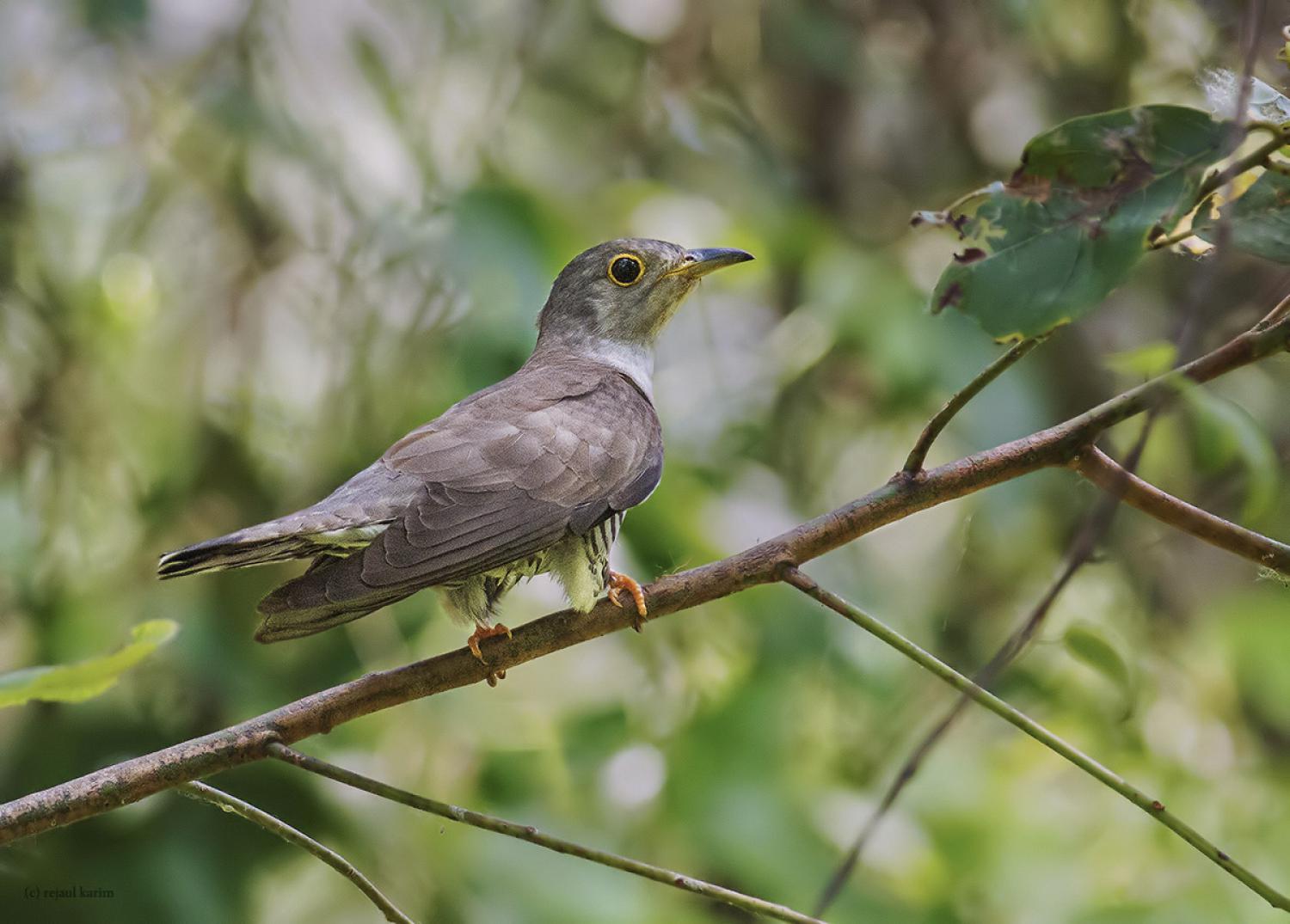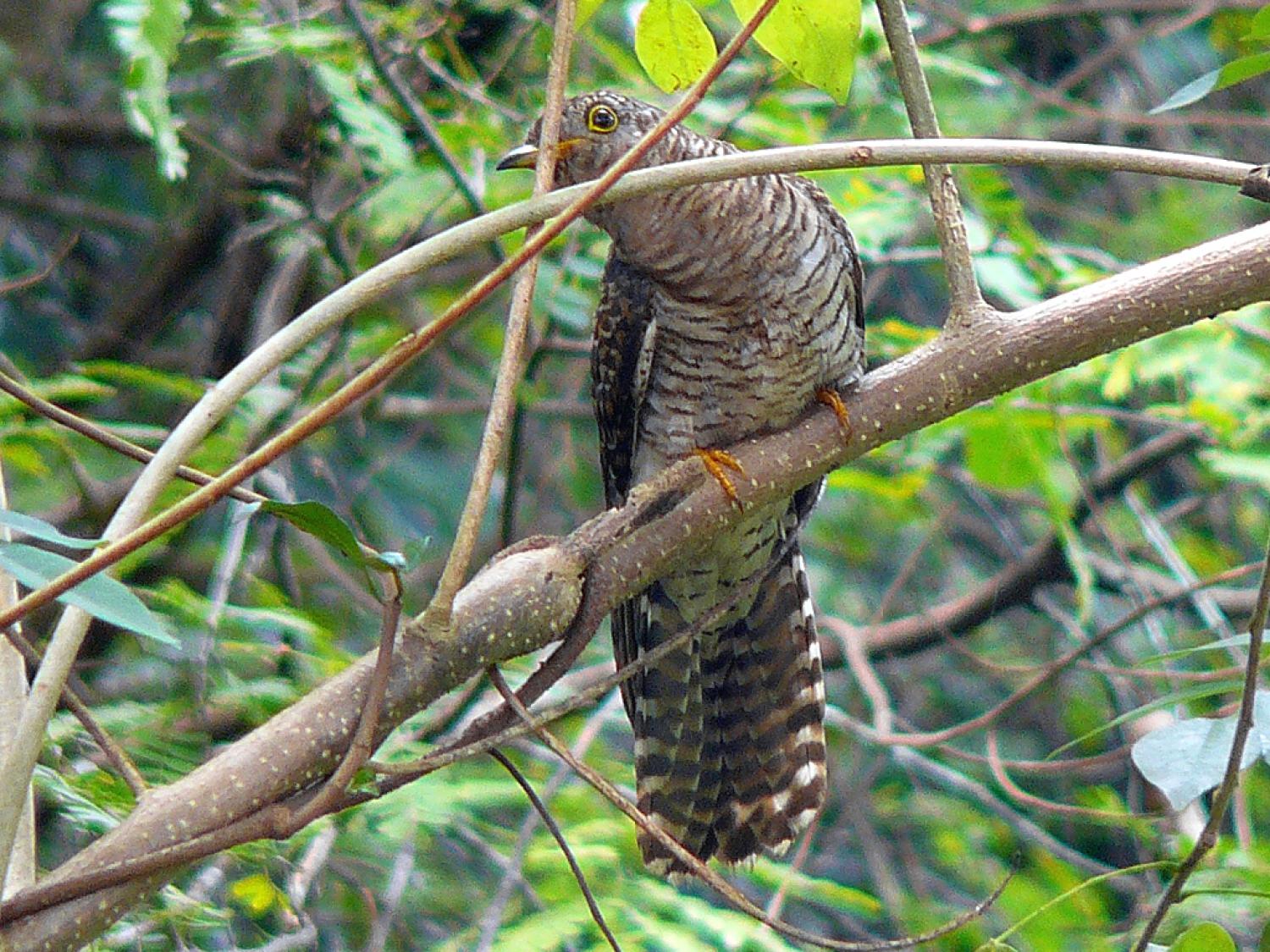Species of Thailand
Indian cuckoo
Cuculus micropterus
John Gould, 1837
In Thai: นกคัคคูพันธุ์อินเดีย
The Indian cuckoo (Cuculus micropterus) is a member of the cuckoo order of birds, the Cuculiformes, that is found in the Indian subcontinent and Southeast Asia. It ranges from India, Bangladesh, Bhutan, Nepal and Sri Lanka east to Indonesia and north to China and Russia. It is a solitary and shy bird, found in forests and open woodland at up to 3, 600 m.
Description
This is a medium-sized cuckoo with both sexes alike. It has grey upperparts while the underside has broad black barring. The tail is barred with a broad subterminal dark band and a white tip. Young birds have white markings on the crown and white chin and throat contrasting with a dark face. Juveniles are browner and have broad white tips to the head and wing feathers. The eye-ring is gray to yellow (a feature shared with the common hawk-cuckoo). The iris is light brown to reddish. The female differs from the male in being slightly paler grey on the throat and in having more brown on the breast and tail. The barring on the belly is narrower than in the male. Nestlings have an orange-red mouth and yellow flanges to the gape.
The call is loud with four notes. They have been transcribed as "orange-pekoe", "bo-ko-ta-ko", "crossword puzzle" or "one more bottle". In northern India, they can be locally common during the breeding season with densities estimated at a calling bird for every 2 km2.
They feed on hairy caterpillars and other insects but sometimes take fruits. They usually feed on the upper canopy, gleaning insects, sometimes making aerial sallies for flying termites or rarely even by hovering lower near the ground.
Taxonomy and systematics
Two subspecies are generally recognized. The nominate form is found in much of continental Asia, while concretus S. Müller, 1845 which is smaller and darker is known from the Malay Peninsula, Java, Sumatra and Borneo. The birds in the Amur region are larger and Swinhoe described a form from northern China as Cuculus michieanus while Walter Norman Koelz described a form fatidicus from northeastern India.
Distribution and habitat
The species is found widely distributed across Asia, from the Indian subcontinent eastwards to Southeast Asia. The preferred habitat is deciduous and evergreen forests but also occur in garden lands and thick scrub.
Some populations in India migrate south in winter, although there are breeding populations in the southern areas as well, with specimens netted at night or recorded at lighthouses. The population in the Amurland of the Russia is migratory.
Behaviour and ecology
The Indian cuckoo is a brood parasite. In Russia, females were found to pair with specific males during the breeding season. The male diverts the attention of hosts from their nest giving time for the female to lay her egg. It lays its single egg mostly in the nests of drongos and crows. Brown shrikes have been recorded as hosts in Russia. The female removes and eats an egg from the host nest before laying her own. The breeding season varies from May to July in northern China, March to August in India, January to June in Burma and January to August in the Malay Peninsula.
The host species include Lanius cristatus in the Amur region, black drongo and Pica cyanea in China. In India, they have been found to be fed by black drongos and ashy drongo. Other hosts that have been recorded include black-headed oriole, streaked spiderhunter, Eurylaimus ochromalus and Dicrurus paradiseus.
The eggs of the cuckoo hatch in 12 days while those of the brown shrike in the Amur region take 15 days. During the third or fourth day, the young bird bends its back when touched and heaves out other eggs or nestlings. This instinct is lost soon after.
In culture
The loud calls have led to numerous cultural interpretations. In Bengali, it is interpreted as "বউ কথা কও (bou-kotha-kao)", "Bride, please speak". In Uttarakhand and Nepal, it is rendered as "kafal pako", or "the kafal fruit (Myrica esculenta) is ripe", as is the case in May–June when calling increases. Very little variation is noted between regions. In the Kangra Valley of India, the call is interpreted as the soul of the dead shepherd uttering "where is my sheep". In China, the call is variously interpreted as "why not go home" (不如歸去), "single lonely" (光棍好苦), "single happy" (光棍好過), "mother-in-law beats me" (家婆打我), "catfish congee" (滑哥煲粥), "myna of pea" (豌豆八哥), "pea and maize corn" (豌豆包谷), "go to cut wheat" (快快割麥), "Grandpa, Grandma, cut wheat, transplant rice" (阿公阿婆,割麦插禾). The Soliga people use the interpretation "ke:ta satto, makka ketto " which translate to "Ketha (a person's name) died, his sons cried".
This article uses material from Wikipedia released under the Creative Commons Attribution-Share-Alike Licence 3.0. Eventual photos shown in this page may or may not be from Wikipedia, please see the license details for photos in photo by-lines.
Category / Seasonal Status
BCST Category: Recorded in an apparently wild state within the last 50 years
BCST Seasonal statuses:
- Resident or presumed resident
- Non-breeding visitor
Scientific classification
- Kingdom
- Animalia
- Phylum
- Chordata
- Class
- Aves
- Order
- Cuculiformes
- Family
- Cuculidae
- Genus
- Cuculus
- Species
- Cuculus micropterus
Common names
- Thai: นกคัคคูพันธุ์อินเดีย
Conservation status

Least Concern (IUCN3.1)
Photos
Please help us review the bird photos if wrong ones are used. We can be reached via our contact us page.
Range Map

- Bang Lang National Park
- Bang Phra Non-Hunting Area
- Bang Pu Recreation Centre
- Bangkok Province
- Chiang Dao District, Chiang Mai
- Chiang Dao Wildlife Sanctuary
- Chiang Khong District, Chiang Rai
- Chiang Saen District, Chiang Rai
- Doi Inthanon National Park
- Doi Lang
- Doi Pha Hom Pok National Park
- Doi Phu Kha National Park
- Doi Saket District, Chiang Mai
- Hala-Bala Wildlife Sanctuary
- Huai Kha Khaeng Wildlife Sanctuary
- Huai Yang Waterfall National Park
- Kaeng Krachan National Park
- Khao Banthat Wildlife Sanctuary
- Khao Luang National Park
- Khao Nam Khang National Park
- Khao Phra - Bang Khram Wildlife Sanctuary
- Khao Sok National Park
- Khao Yai National Park
- Khun Chae National Park
- Khun Nan National Park
- Klaeng District, Rayong
- Ko Chang National Park
- Ko Lanta National Park
- Ko Phra Thong
- Mae Fa Luang District, Chiang Rai
- Mae Ping National Park
- Mae Wong National Park
- Mueang Khon Kaen District, Khon Kaen
- Mueang Krabi District, Krabi
- Mueang Suphanburi District, Suphan Buri
- Mueang Tak District, Tak
- Nam Nao National Park
- Nong Bong Khai Non-Hunting Area
- Pa Sang District, Lamphun
- Pai District, Mae Hong Son
- Pak Phanang District, Nakhon Si Thammarat
- Pak Thale
- Phu Phan National Park
- Phutthamonthon District, Nakhon Pathom
- Sakaerat Environmental Research Station
- Samae San Island
- Samut Prakan Province
- Similan Islands
- Surin Islands
- Thale Ban National Park
- Thap Lan National Park
- Ton Nga-Chang Wildlife Sanctuary
- Yan Ta Khao District, Trang

